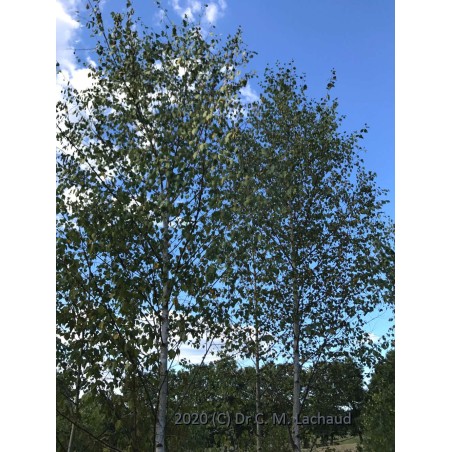




-
Betula pendula is an elegant, fast-growing tree with a typical bark, white and smooth when young, gray and cracked as it ages
Young twigs are often drooping, giving the tree a graceful aspect
Birch leaves are triangular, pointed, serrated, of a pretty green
They are deciduous, and in the fall take on a magnificent golden color
The White Birch blooms at the end of winter
Its flowers are grouped into catkins and are pollinated by the wind
Betula pendula is a very hardy tree - pioneer and colonizer
It survives in very cold regions of the globe and resists to pollution
Betula pendula appreciates open locations
It grows easily on poor, acidic and siliceous soils, and thrives on both dry and moist soils
In spring, Birch Water is drawn from the trunc of this tree
Birch has many medicinal properties : Anti-cholesterolemia, Anti-inflammatory, Anti-rheumatic, Antiseptic, Astringent, Cholagogue, Diaphoretic, Diuretic, and Laxative
Traditionally, birch has been used in many ways
It was a source of Wood, Charcoal, Compost, Fiber, Fungicide, Glue, Paper, Repellent, Tannin
White Birch is also a source of dye, both wash and light fast
Spring leaves give bright Yellows
Summer leaves give dark Browns with iron salts
-
| Jan | Feb | Mar | Apr | May | Jun | Jul | Aug | Sep | Oct | Nov | Dec | ||
|---|---|---|---|---|---|---|---|---|---|---|---|---|---|
| Z2 | etc. | ||||||||||||
The seeds of Betula pendula are sown on the surface of moist soil, as soon as they ripe in autumn, or later in winter and early spring
They germinate with the first spring warmth
Keep the young plants in the nursery for 2 years before transplanting to their final location
-
Harvest the young leaves while still tender in spring for low-tannin dyes
Harvest the leaves in August for tannic dyes that will give different colors
Dry well for later uses
Learn to Use Birch Leaves for Dyeing with our Courses:
You might also like
Payment :
PayPal < 150 €
Check < 850 €
Bank Wire > 149 €
Thank you for your kind understanding